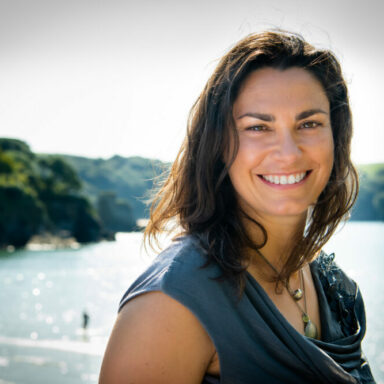The beauty of food waste: how Professor of Sustainable Materials Richard Blackburn has turned fruit scraps into skincare

An astonishing one third of all food produced for human consumption gets wasted globally every year. But green chemists are finding clever ways to use unavoidable waste – things like fruit peel and stones – and transforming them into useful, and crucially biodegradable, products that could contribute to a more circular food system.
For Richard Blackburn, Professor of Sustainable Materials at Leeds University, things like blackcurrant skins from Ribena production, grape skins from vineyards and mandarin peel from China offer up enormous opportunities to innovate. “Food waste represents a really amazing untapped resource,” he says. But we shouldn’t really just be thinking simply about food waste though, according to Blackburn, because so much is unnecessarily wasted and that would only create a false circular economy. “Inevitably with some food products, we get very good clean streams of by-products and that’s the resource that we’re not really tapping into enough yet.”
Take mandarins, for example. “About 10M tonnes of mandarin peel get incinerated every year,” says Blackburn. “Like all citrus, mandarin peels are difficult to compost because they have evolved to be protective, with lots of amazing chemistry that prevents degradation.” That makes it difficult to manage as a waste stream and it’s also energy-intensive to do so. It’s this type of food waste that poses the biggest problem. But Blackburn has a solution.
At his lab, he extracts ingredients from some of these discarded by-products and creates new cosmetic and skincare products. His green beauty company, Dr Craft, imports dried mandarin peel from China (this is lighter to transport than fresh peel) and makes a liquid using an energy-efficient extraction process without any toxic solvents.
This extraction process actually makes the mandarin waste biodegradable too so it doesn’t need to be incinerated. “Previously, that mandarin peel wouldn’t biodegrade quickly enough for it to be utilised, but after it has been through our extraction process so we can take out the good bits, our residual mandarin peel is biodegradable so it’s a win-win situation. We have effectively treated the waste while capturing a high value material out of it.”
He has extracted grape seed oil and an antioxidant called resveratrol from the skins of red pinot noir grapes collected from English wineries in order to make body care products, while the avocado stones that remain after using the fruit in guacamole, soups and sandwiches make the ideal plant-based exfoliator without the need to use land to grow more crops. With the dried blackcurrant skins that remain after the production of Ribena, he makes purple hair dye and after he has removed the particular substances required for his beauty products, the remaining blackcurrant skins get still used for soil mulching, as they did previously. So this green chemistry is all about designing out waste by adding in an extra high value step to the process.
When it comes to reframing food by-products as a valuable resource, we’re only looking at the tip of the iceberg, according to Blackburn. But there are various challenges associated with repurposing any waste. Contamination can play havoc with the raw materials. Blackburn often works directly with farmers and food producers so that’s easier to control, but when he’s worked with supermarkets in the past, the mixing of waste streams can pose problems at various stages of the supply chain. Take grapes, for example. “Some perfectly good food grade grapes get wasted when some are trimmed off at the packaging stage by the supermarket then that gets mixed with other food waste. So how do we deal with that mixture of different materials? If it had gone off into separate streams, we could have taken all the good grapes more easily. But the current system isn’t set up to make it easy to use those waste streams,” he explains. “If that’s done well, it’s a real opportunity.”
Primarily, Blackburn is looking at nature for two things. “We’re looking to see if there are materials that are sustainable in terms of their sourcing; I’d put food by-products in that category. Then, we’re looking to see whether there are any interesting chemistries in there that we can confidently and reliably say that demonstrate they have an activity that we can put into a material.” So the Dr. Craft formulations are not just driven by the need to add more ‘natural’ ingredients. “We’ve got a grape range coming out soon where we’re using the grape skins as the active ingredient in our skincare products. We’re using grape seed oil because it’s a by-product plus it’s amazing in terms of how it absorbs into your skin and delivers the active ingredients – so there’s a sustainability and a science story around that.”

Professor Richard Blackburn

Professor Richard Blackburn’s skincare line, Dr Craft
Left: Professor Richard Blackburn
Right: Professor Richard Blackburn’s skincare line, Dr Craft
But chemophobia amongst consumers can be a real issue, he says. “People get a bit frightened of chemistry, but nature is doing chemistry all the time. We’re making stuff in the lab based on taking two products from nature and bolting them together to make something new with a clever function. So we’re using something that already exists to create something new.”
The purple hair dyes made from blackcurrants don’t dissolve in oil, so Blackburn has developed a way to attach an oil onto the end of the pigment using a naturally-occurring enzyme.
Ultimately, Blackburn wants everyone to look at the bigger picture. “Instead of being frightened of chemistry, people should be frightened of what the full life cycle issues are. Often natural products can be terrible for the environment.” So his lab developments involve innovative chemistry and rigorous analysis to optimise the process and manage any impacts on the environment. “We’re scientists, yes we run a company but we’re also staking our academic reputations on this as well. We need to make damn sure that what we’re doing holds up from a sustainability perspective so we really scrutinise this – is this really the most sustainable product, process, ingredient, to get to what we want to make? We want to make sure that what we know exactly what that extract is, how pure it is etc.”
During the production process, there’s a risk that an unwanted ingredient could also be extracted too. “When we do an extraction, we want to know we’ve got the ingredient we really want in there but at the same time, we don’t want to unintentionally concentrate up some other ingredient that might occur naturally that then causes a problem,” says Blackburn, who explains that some compounds in lime peel can make skin more photosensitive, resulting in bad burns and skin blisters. “We test all of our extracts to make sure that those types of chemicals do not occur in our extracts, so we test it for what we do want but also make sure we’re not including anything else that we don’t want as well. That’s really important.”
Next, his team are looking into sourcing waste protein from things like peanuts, milk waste, soy by-products and he says there’s huge potential to use this in textiles as well as personal care products.
“A lot of thought goes into design, but there’s also a lot of care in terms of quality control. Not every company has those strong chemical analytical skills,” adds Blackburn. “We’re combining that world class chemical analytical facilities and knowledge with sustainability principles in a cosmetic lab. That’s where we’re different.”









